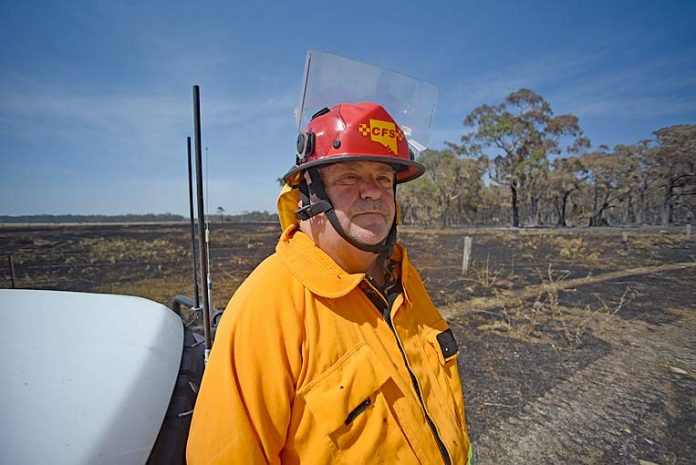

PENOLA and surrounding areas Country Fire Service (CFS) brigades joined crews across the region to battle a bushfire at Keilira which had burned almost 25,000 hectares.
The bushfire continued to burn in dense scrub yesterday and crews will continue to extinguish the fire for the next few days, using heavy machinery to create breaks outside of the fireground.
Started by lightning strikes, firefighting crews were unable to control the blaze on Monday as it burned in extreme fire conditions west of Padthaway.
The fire burned in dense scrub and vegetation making it difficult for CFS volunteers to access.
A wind change on Monday afternoon caused the fire to spread uncontrollably and it had burned 24,750 hectares by press-time yesterday.
The fire was raised to a Level 2 incident on Monday and residents in the area were advised to watch and act as the blaze threatened a number of properties.
Wattle Range CFS group officer Fred Stent joined a strike team of five crews to help fight the blaze on Monday night.
Speaking to The Pennant after arriving home from the shift yesterday morning, Mr Stent said it was a busy night on the fireground.
“We started at around 7.30pm and finished at 6.30am,” Mr Stent said.
“We were involved in back-burning and patrolling the fire, which was going very well all night,” Mr Stent said.
Mr Stent said there were three fronts of the fire and crews were first required to tackle the south-eastern front.
“It took us around four hours to get that under control, I think we did a reasonably good job,” Mr Stent said.
“It was burning in pretty thick scrub, we could not get in there, so were just made breaks and waited for the fire to come out.”
Mr Stent said the wind made firefighting difficult all evening.
“It was pretty intense as the winds were up fairly well, so we just had to slow the fire as much as we could,” he said.
“We protected three or four properties throughout the evening.”
The fire was reduced to a bushfire advice message yesterday.
Rapid damage assessment teams visited the fire ground yesterday to assess items damaged during daylight hours.
A CFS spokesperson said they had every confidence in the crews who would monitor the fire over the coming days.
The CFS has urged motorists to exercise caution as there was significant smoke in the areas which may limit visibility across the Riddoch Highway and surrounding areas for the next few days.
Meanwhile, Wattle Range CFS groups were among firefighters who controlled a bushfire caused by a dry lightening strike south of Nangwarry on December 21.
More than 200 of the region’s firefighters responded to the incident, which started in a paddock on Pow Lane, with more than 50 appliances from the CFS and forestry firefighting groups deployed to the blaze.
Hundreds of firefighters were required to attend a number of other blazes throughout the Limestone Coast during the catastrophic conditions on December 20, including a fire near Coonalpyn.
The fire burned more than 5600 hectares of farmland and a large portion of the Carcuma Conservation Park.
Across the border, a number of fires started in the south west Victoria region as a result of lightening.
The fire burned more than 1000 hectares of land west of Casterton, around the Dartmoor and Digby areas.







